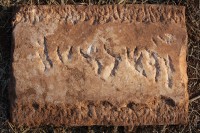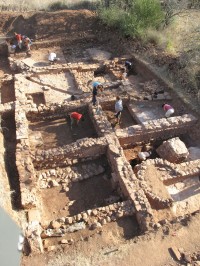 Archaeologists from the Friedrich Schiller University Jena in Germany have uncovered the oldest evidence of Jews living in the Iberian peninsula: a 16-by-24-inch inch marble slab inscribed with the name “Yehiel” in Hebrew. Researchers believe it may have been a tomb slab. Antlers found in rubble next to the slab were radiocarbon dated to 390 A.D., which means that the slab is at least that old if not older. That makes it the oldest evidence of Jewish inhabitants on the Iberian Peninsula.
Archaeologists from the Friedrich Schiller University Jena in Germany have uncovered the oldest evidence of Jews living in the Iberian peninsula: a 16-by-24-inch inch marble slab inscribed with the name “Yehiel” in Hebrew. Researchers believe it may have been a tomb slab. Antlers found in rubble next to the slab were radiocarbon dated to 390 A.D., which means that the slab is at least that old if not older. That makes it the oldest evidence of Jewish inhabitants on the Iberian Peninsula.
Before this discovery, the earliest archaeological evidence of Jews living in what is now Portugal was a tomb slab from 482 A.D. that was inscribed with a menorah. There was text on that slab as well, but it was in Latin. The earliest Hebrew inscriptions came considerably later, in the 6th or 7th century A.D.
The find was surprising not just for its age, but also its location. The site where the slab was unearthed is a Roman villa first discovered in 2009 by Portuguese archaeologist Jorge Correia during an archaeological survey around the village of São Bartolomeu de Messines in the Algarve region of southern Portugal. This is a remote spot, far from the urban centers of the Roman province of Lusitania. Archaeologists were not expecting to find evidence of Jews and Romans living together in such a rural area, and it’s the first time a Jewish artifact has been found inside a Roman villa.
 Actually, the Jena researchers were hoping just to find any inscriptions at all that would tell them about Roman-era life far from the well-excavated centers of west coastal Portugal. Hebrew inscriptions were the last thing on the list, especially from this time period. Theodosius I, the last emperor of both the western and eastern Roman Empire, had made Nicene Christianity the sole official state religion in 380 A.D. The new state-enforced dominance of orthodox Christianity made for an ugly environment for anyone of a different religious persuasion. Fearing persecution, Jews during this time wrote in Latin rather than Hebrew.
Actually, the Jena researchers were hoping just to find any inscriptions at all that would tell them about Roman-era life far from the well-excavated centers of west coastal Portugal. Hebrew inscriptions were the last thing on the list, especially from this time period. Theodosius I, the last emperor of both the western and eastern Roman Empire, had made Nicene Christianity the sole official state religion in 380 A.D. The new state-enforced dominance of orthodox Christianity made for an ugly environment for anyone of a different religious persuasion. Fearing persecution, Jews during this time wrote in Latin rather than Hebrew.
Perhaps that’s part of why the Hebrew in this inscription was so roughly carved. The archaeologists couldn’t even identify the language at first, so poorly were the letters rendered.
Only after long research the Jena Archaeologists found out which language they were exactly dealing with, as the inscription was not cut with particular care. “While we were looking for experts who could help with deciphering the inscription between Jena and Jerusalem, the crucial clue came from Spain” Dennis Graen says. “Jordi Casanovas Miró from the Museu Nacional d’Art de Catalunya in Barcelona — a well-known expert for Hebrew inscriptions on the Iberian Peninsula — is sure that the Jewish name “Yehiel” can be read, — a name that is already mentioned in the Bible.”
There are more letters after the name which have yet to be identified. The Jena team has excavated 1722 square feet (160 square meters) of the villa already, but most of the site is still under ground. The archaeologists will pick up where they left off this summer.